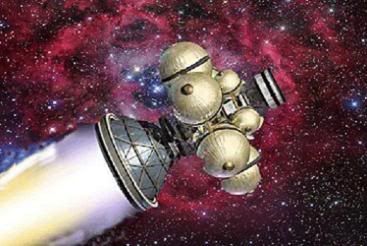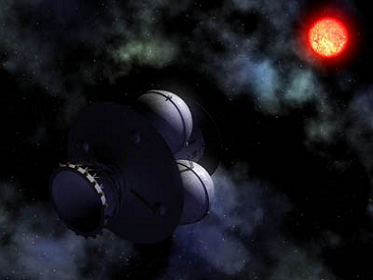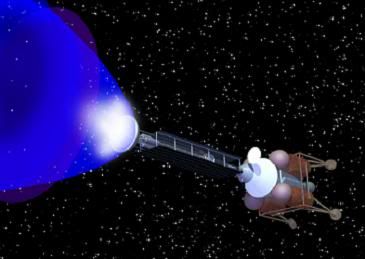Post by glactus on Oct 22, 2011 1:19:41 GMT

Daedalus at the Rosetta nebula
The Daedalus star ship, proposed in the 1970s, would propel itself forward using controlled fusion explosions and would take 50 years to reach Barnard's Star, nearly 6 light years away. Many believe that humanity's destiny lies with the stars. Sadly for us, rocket propulsion experts now say we may never even get out of the Solar System.

Daedalus approaching Barnard's star
At a recent conference, rocket scientists from NASA, the U.S. Air Force and academia doused humanity's interstellar dreams in cold reality. The scientists, presenting at the Joint Propulsion Conference in Hartford, Connecticut, analyzed many of the designs for advanced propulsion that others have proposed for interstellar travel. The calculations show that, even using the most theoretical of technologies, reaching the nearest star in a human lifetime is nearly impossible.

Our nearest star Alpha Centauri
"In those cases, you are talking about a scale of engineering that you can't even imagine," Paulo Lozano, an assistant professor of aeronautics and astronautics at the Massachusetts Institute of Technology and a conference attendee, said in a recent interview.

An Antimatter starship
The major problem is that propulsion -- shooting mass backwards to go forwards -- requires large amounts of both time and fuel. For instance, using the best rocket engines Earth currently has to offer, it would take 50,000 years to travel the 4.3 light years to Alpha Centauri, our solar system's nearest neighbor.
Even the most theoretically efficient type of propulsion, an imaginary engine powered by antimatter, would still require decades to reach Alpha Centauri, according to Robert Frisbee, group leader in the Advanced Propulsion Technology Group within NASA's Jet Propulsion Laboratory.
And then there's the issue of fuel. It would take at least the current energy output of the entire world to send a probe to the nearest star, according to Brice N. Cassenti, an associate professor with the Department of Engineering and Science at Rensselaer Polytechnic Institute. That's a generous figure: More likely, Cassenti says, it would be as much as 100 times that.
"We just can't extract the resources from the Earth," Cassenti said during his presentation. "They just don't exist. We would need to mine the outer planets."
But the thought experiments continue. At the conference, Frisbee presented a theoretical design for a ship using antimatter to propel its way to nearby stars.
"It's always science fiction until someone goes out and does it."
Credits: These are non copywrite images
TexT: This is part text only. See full text and all scientists involved at wired.com
www.wired.com/science/space/news/2008/08/space_limits?currentPage=all


